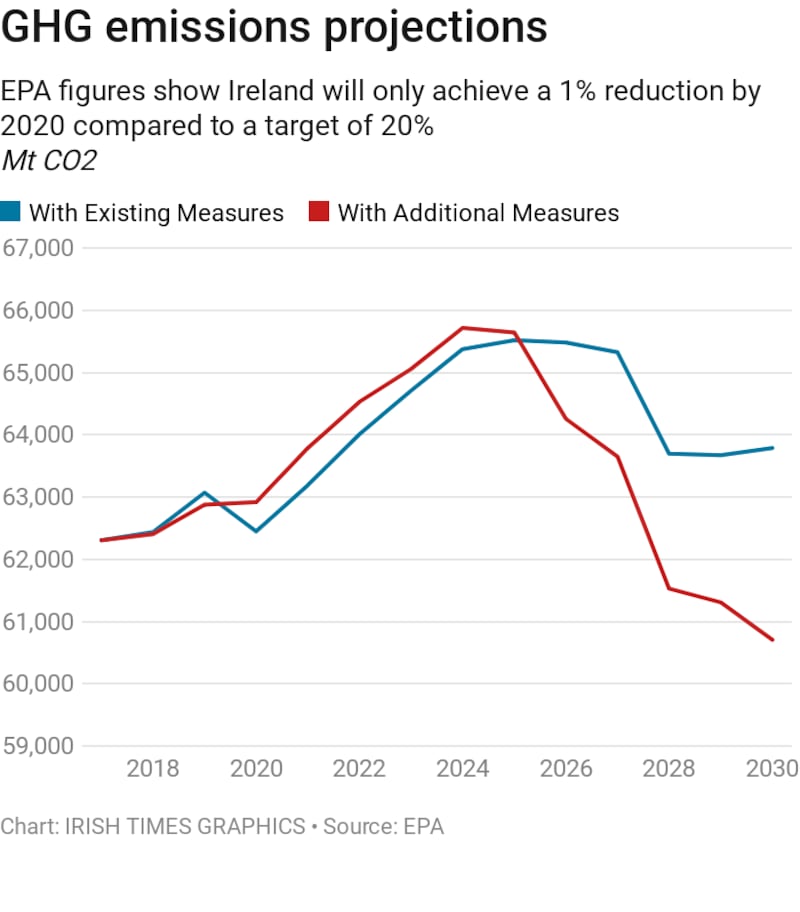Ireland’s total greenhouse gas emissions are set to increase up to 2020, driven by strong economic growth, according to the latest Environmental Protection Agency projections.
Increasing fossil fuel consumption, under pinned by relatively low fuel prices, and an expanding agriculture sector in particular are the big elements leading to increased emissions, which contribute to global warming.
Ireland has committed to a legally-binding EU target Ireland of reducing by 20 per cent (on 2005 levels) greenhouse gas emissions coming from agriculture; transport, residential buildings, commercial activity, "non-energy intensive industry" and waste including incineration.
The latest projections released on Thursday show, at best, Ireland will only achieve a 1 per cent reduction by 2020 compared to the 20 per cent reduction target – and will struggle to meet 2030 targets on key sectors that are not part of the EU’s emissions trading system which covers heavy industry.

This raises the prospect of substantial financial penalties over the coming decade, though the European Council introduced "two new flexibilities to allow for a fair and cost-efficient achievement of the targets" earlier this month.
Most EU countries are already achieving emissions reductions based on overall national figures.
In light of the latest Irish figures, the EPA has highlighted the need for a decisive move away from fossil fuels use through significantly improved energy efficiency and use of cleaner, renewable fuels to counter the rising emissions scenario.
Exacerbating factors highlighted by the EPA are:
* Energy industry emissions – mainly from power generation – are projected to grow strongly from 2020 to 2025 as a result of continuing use of coal and expansion of “co-firing of peat and biomass”;
* Transport emissions are projected to increase from current levels by 17 to 18 per cent by 2020, and by 17 to 20 per cent by 2030 including a growth in fuel consumption in diesel cars and freight up to 2025. A decline in emissions is projected from 2025 to 2030, resulting from an acceleration in the number of electric vehicles on Irish roads;
* Agriculture emissions are projected to increase by between 3 to 4 per cent by 2020, and 6 to 7 per cent by 2030 on current levels based on an expansion of animal numbers, particularly in dairying – Ireland has committed to “carbon neutrality” in agriculture; the single biggest contributor to emissions in the economy.
In relation to 2030, Ireland’s target calls for a 30 per cent reduction of carbon emissions compared to 2005, with binding annual limits over the 2021 to 2030 period.
The latest projections indicate Ireland “will exceed the allowable carbon budget implied by those limits by between 47 to 52 million tonnes of over the period, even assuming the allowed-for flexibilities are fully used”.
Director of EPA Office of Environmental Sustainability Dr Eimear Cotter said: "The EPA's latest greenhouse gas emissions projections show emissions will continue to grow in tandem with economic growth in the absence of significant new policy interventions. There will be strong growth in the short term in emissions from transport driven by increased fossil fuel consumption, while continued use of coal and peat in power generation offsets the addition of new renewable generation."
Ireland is committed to becoming a low carbon economy and society, while a significant number of new or extended measures have been announced in the recent National Development Plan and the National Mitigation Plan.
EPA senior scientist Stephen Treacy said: "Transforming our society to low carbon has associated climate and health benefits, and our projections show we are currently not on track to meet this ambition or meet our EU targets."
The anticipated impact of recently announced policies and measures had yet to be incorporated into the projections, he confirmed. “This needs to happen as soon as possible to ensure that we have the best information available on Ireland’s future emissions’ trajectory and the impact of these Government policies. This will inform robust policy decisions into the future,” he added.
The Greenhouse Gas Emission Projections 2017 to 2035 report is available on the EPA website epa.ie















